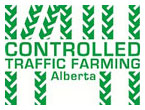Agronomist Notes
Happy New Year and welcome to Volume 5, Issue 1 of Beyond Agronomy News! I hope you had a refreshing Christmas break and are ready to tackle 2010. In the months ahead, I will be challenging you (and myself) to analyze new concepts, new ways of tweaking our cropping systems and to look at agronomy decisions from new angles.
In this week’s issue we’ll get down to business right away and run the numbers on comparing custom applications of ammonium sulphate fines and using regular ammonium sulphate in your spring fertilizer blend at seeding. Next, we’ll discuss a new concept called ‘row loading’ and how it could fit into our crop nutrition programs. I’ll also briefly look at the cost of setting up a liquid injection system to begin the feasibility study on the row loading concept. Finally, we’ll finish with fundamental and technical grain market news. Carbon Market News will return next week.
Have a great week.
Steve
Agronomy
Crunching the numbers on ammonium sulphate fines
A growing number of producers are choosing to broadcast ammonium sulphate fines over the winter in order to increase seeding efficiencies in the spring. Broadcasting sulphur fines can eliminate roughly 100 lbs/ac from your spring blend and significantly reduce fill times. Also, sulphate fines (21-0-0-24) typically carry a $100 a tonne or $0.19 lb discount to regular ammonium sulphate which just about offsets the $7.00/ac cost of custom application. I’ve recommended the product for a few clients and used it successfully on our own wheat in 2008.
The biggest risk for broadcasting sulphate is the potential for movement off the target site so topography becomes your limiting factor. Fields with steep slopes that are prone to water runoff are not good candidates. Sulphate (SO4-) is negatively charged and will not bind to clay or organic matter. The nitrogen (NH4+) component, on the other hand, is positively charged and binds well to clay and organic matter, consequently reducing the risk of movement off target.
So, let’s get down to the economics.
Steve’s quick math
Efficiency gain: For those of you with limited labour available, eliminating 100 lbs/ac of product in the spring will increase the number of acres seeded between fills. For this example we’ll use a 250 lb/ac spring fertilizer blend in the middle and back compartments of a 430 bushel tank.
Full blend: (186 bu back + 102 bu middle) = 288 bu x 60 lb/bu x 85% ÷ 250 lb/ac = 59 acres per fill
Sulphate fines: (186 bu back + 102 bu middle) = 288 bu x 60 lb/bu x 85% ÷ 150 lb/ac = 98 acres per fill
There you have it- seeding efficiency is increased 66% by adding an additional 39 acres per fill! With a 50-foot drill at 5 mph you can remain seeding for an extra 1.3 hours between fills.
Cost comparison: Let’s compare sulphate fines 21-0-0-24 applied at 100 lbs/ac plus application costs to applying 100 lbs/ac of regular ammonium sulphate in the drill at seeding. Sulphate fines cost $250 a tonne or $0.11 lb of product. Application costs are $7.00 acre. Regular ammonium sulphate is $350 a tonne or $0.16 lb of product. Urea prices today are $410 a tonne. I’m using prices per pound of product to keep things simple.
Sulphate fines: 100 lbs/ac x $0.11 lb + $7.00/ac custom application = $18.00 ac
Regular blend: 100 lbs/ac x $0.16 lb = $16.00 ac
The additional cost of applying sulphate fines is $2.00 per acre compared to using regular ammonium sulphate in your spring fertilizer blend. In my opinion, the potential for added efficiency gains of 39 acres per fill more than outweighs the additional cost of applying it. SL
Row loading: A new concept in crop nutrition
On my travels to Australia last year I discovered a concept called row loading. Simply put, row loading uses liquid nutrition products to “load the seed row” with a combination of micro and macro nutrients, biological agents, growth promotants and inoculants. Row loading is used to provide sustained nutrient availability and enhance the conditions in the immediate root zone to encourage strong root development and hormone production. I believe we can improve profitability and response to crop nutrition products by utilizing the row loading concept here in Western Canada.
In the push to seed early in our narrow twenty day window, we typically find ourselves direct seeding into cold, frozen, wet soil with heavy residue. These conditions tend to slow root growth, limit the plants ability to absorb nutrients and reduce hormone production. For example, look at the chart above and notice where the hormone cytokinin meets auxin in the place called cell initiation. This is the time when the number of heads, kernels and tillers in each plant are determined. Unfortunately, auxin production is limited and becomes abnormal when soil temperatures fall below 21 degrees Celsius. Our soils don’t typically rise above 21 degrees Celsius until the middle of June, after yield potential is already set! This is where row loading has a fit.
For example, even though soils may be high in nutrients like calcium, over supplying the nutrient during cell initiation ensures there is more than enough calcium to drive crucial process like auxin production. Calcium stimulates root and root hair growth which in turn stimulates auxin production. Stimulating auxin production and cell division through row loading calcium can help plants overcome their normal response to cold soil temperatures. Bottom line: row loading allows you to place calcium as close to the roots as possible in order to receive the maximum benefit.
It all comes down to the ability of our crop nutrition programs to deliver the right amount of nutrients in the right place at the right time and that’s where I see row loading fit our current system. Straight granular systems simply can’t give the advantage that row loading products do. I used calcium as an example here but any macro or micronutrients, liquid humates, biological stimulants, liquid fungicides or whatever else could be added to the list.
Now, I understand the limiting factor with row loading requires that we add a liquid injection system to our seeding tool. That would mean another controller in the cab, more hoses and another tank. However, I believe it will give us the flexibility to apply the right products at the right time instead of blanket applying nutrition across the entire farm. Setting up to seed prime almost forces us to apply seed primers and other products to all our seed to keep things simple logistically. Using an additional tank would allow us to pour and go instead of augering the seed, timing the rate of seed through the auger and crossing our fingers that the product is evenly applied. It would also allow us to apply higher rates safely because we’re not placing products directly on the seed.
Row loading is an exciting new concept that has my interest peaked with loads of potential to add to our current granular fertilizer programs. There’s still time to investigate the costs of setting up a liquid injection system before spring and I would suspect it’s not outrageous or as intimidating as inter-row seeding or controlled traffic. I’ll be hunting for more research to show you on row loading in the near future but until then, its food for thought. SL
Adding a liquid injection system to your seeding implement
Further to my article above on row loading, I’ve done a little pricing on liquid delivery systems. The way I see it, there are three options. First, a standalone 250 gallon/ 1,000 L tank plus liquid metering system could be mounted on the air cart or tool bar. High product rates aren’t typically needed when row loading in combination with granular fertilizer; the most applied at one time might be 3 litres per acre so a 1,000 or 1,500 L tank is sufficient. The second option is limited but John Deere sells a liquid tank option on their 1910 air cart. Thirdly, you could purchase a tow behind 10,000 L liquid tank. I’m not excited about towing another cart so I’ll focus on the first two options.
Option 1: Raven SCS Sidekick Injection System- $6,700+
The Raven SCS Injection system comes equipped with a 4-digit display console, 15-foot and 27-foot cables along with a duel piston positive displacement pump that delivers 150 to 6,000 ml per minute. The price tag is $6,700, not including the larger tank and delivery lines to each shank. All in, I think you’d be about $10,000.
Specs: http://www.ravencanada.com/Manuals/pdf/016-0159/819E.pdf
Option 2: John Deere Liquid Fertilizer tank option- $2,260 US
The liquid middle tank option on the John Deere 1910 comes with a $2,260 US discount because they no longer provide you with a dry metering system and roller. Basically, a smaller hole is cut in the top of the tank at the factory and the molded metering system is cut out from the bottom. You must supply your own liquid metering system but I was told that you could probably engineer the Raven Sidekick to work.
At first glance a liquid delivery system looks to run between $7,000 and $10,000. That seems fairly pricey and I’ll have to look at more options. However, I do believe the benefits of liquid injection or row loading will more than offset the cost. On a typical 4,000 acre farm growing 2,000 acres of wheat that averages 45 bu/ac at $5.00 a bushel, you’d need a 2.22% yield increase to recover your costs in the first year. Suddenly, the initial cost doesn’t seem so high. More food for thought! SL
Market News
Commodity Fundamentals
USDA, December 2009
Technical Analysis
Canola: January Futures. The short and long term trends are up.
HRS Wheat: March Futures. Short term trend is choppy. Long term trend is up.
Corn: March Futures. The short and long term trends are up.
Soybeans: March Futures. Short term trend is choppy. Long term trend is up.
Crude Oil: February Futures. Short and long term trends are up.
Canadian Dollar: March Futures. Long and short term trends are up.
US Dollar Index: March Futures. Long term trend is up, short term trend is down.





